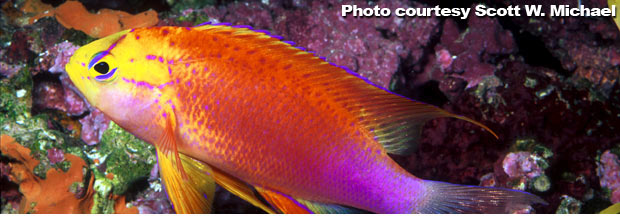Keeping the Jewels of the Reef:
The Anthias of the Genus Pseudanthias - Part 3
By Scott W. Michael  As mentioned earlier, anthias can make an attractive piscine addition to the reef aquarium. They are especially sought after by coral-keepers because they do not harm ornamental invertebrates. All the Pseudanthias species are zooplankton-feeders. They eat small organisms that float around in the water column, including copepods, crustacean larvae, and fish eggs. They are very active, flitting about the water column, picking off zooplanktors.
One real problem with keeping these fishes in the reef aquarium is to ensure that they get enough to eat. Many reef aquarists are reluctant to frequently add fish food to the tank. The average reef-keeper may only feed their fish once a day, or in some cases, less often than that. The premise is, if you add lots of food, pollutant levels (e.g., dissolved organic materials) are more likely to rise, which could lead to poor water quality and associated algal blooms. Since zooplankton is usually in short supply (at least the amount required to nourish one or more zooplankton-feeding fishes) anthias often suffer from malnutrition in the reef aquarium. Today, more reef aquarists are employing effective
foam fractionators (protein skimmers) to help reduce the build-up of certain pollutants. Also, coral caretakers are also beginning to realize that many of these invertebrates "appreciate" the addition of these foods as they can be an important source of nutrients for corals as well as fish. If you are reluctant to frequently feed fish in your reef tank, stay away from anthias!
Zooplankton culture, like mysid shrimp,
copepods and amphipods, are available that can be added to the refugia. These small crustaceans can be fed
aquarium flake food and plant material and are typically very prolific. They provide a natural and constant food source for any anthias housed in that aquarium. They also provide a more nutritional food source, that can facilitate chromatic fidelity in these fishes, which are notorious for losing their color. Another advantage to having a well-stocked refugia is that you will not have to introduce food as frequently to ensure your anthias gets enough to eat.
Frozen mysis shrimp have also made it easier to keep certain Pseudanthias spp. as these fish have a hard time resisting these tiny crustaceans. Make sure the frozen mysid you use is not a mushy mass when thawed. Rather, the shrimp should be whole and solid. Place a chunk of frozen mysids into a cup of water from the aquarium and then pour off the water and associated swill before actually adding the shrimp to your aquarium (this will reduce the amount of pollutants you are introducing to your system). One problem with mysids, is that they lack some pigments required to keep your anthias from losing their brilliant colors. Supplement a mysid diet with some of the
color enhancing flake foods. Many of the anthias will accept flake foods once they have fully acclimated to captivity.
Another great anthias food that has only recently appeared in aquarium stores is
Cyclop-EEZE®. This is a very nutritious food (e.g., high HUFA and protein content), it remains in suspension longer than many foods, and most anthias love it (larger Anthiines may ignore it)! Because of its tendency to stay in suspension, it gives zooplanktivores more time to pick the food particles out of the water column. When you feed them, it is best to place the food in the out flow of a water pump, so that it moves through the water column like their natural prey. I should point out, that coral's love to eat it too!
 Scott Michael
Scott MichaelScott W. Michael is an internationally-recognized writer, underwater photographer, and marine biology researcher specializing in reef fishes, and was the Banquet Speaker at our 2007 and 2008 Coral Conference and Frag Swap. He is a regular contributor to Aquarium Fish Magazine, Freshwater and Marine Aquarium Magazine, SeaScope, and is the author of Reef Fishes Vol 1, Vol 2, and Vol 3, Vol 4, and Vol 5., A Pocket Expert Guide Marine Fishes, A Pocket Expert Guide to Reef Aquarium Fishes, 101 Best Saltwater Fishes: How to Choose and Keep Hardy, Brilliant, Fascinating Species That Will Thrive in Your Home Aquarium, Reef Sharks & Rays of the World, and Aquarium Sharks & Rays. Having studied marine biology at the University of Nebraska, Scott has served as a scientific consultant for National Geographic Explorer, the Discovery Channel, and French educational television. |
|||||||||
|
|





